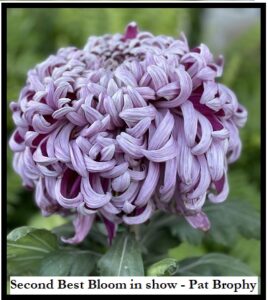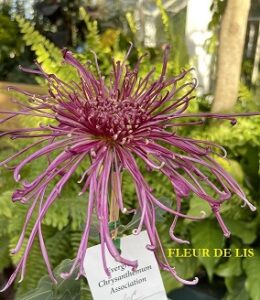June 2021 Cultural “To Do” List
Stopping:
Most plants are stopped April 15 through June 1, including the Early English classes. Keep your stop list handy and follow it rigorously. The calendar doesn’t move backwards. For #1 and #2 varieties the English literature recommends a fairly hard pinch; that is pinching 6-8 leafs down from the growing tip. For the incurves, #3, #13, #23 pinch the smallest portion of the growing tip to get more uniform growth of the laterals. For all varieties, fertilize 1-2 weeks before pinching to produce more laterals. This is especially true for the Fairweathers.
Feeding and pest management
- After 3 weeks in final pot start summer feeding program. ` 1 1 to 2 Tsp. Peters 20-10-20 per gallon water, once a week.
Note: Some plants will thrive with the heavier solution, while others
may not like so much fertilizer. Watch the leaves to gauge the fertilizer needed. If leaves become hard and curl up you are overfeeding. If leaves are somewhat weak and lighter green then more fertilizer would help. Miracle Grow is also used quite successfully by some during this summer stage.
- If plants are yellowish, first try drying them out. If drying the plant is unsuccessful, feed ½ tsp. Epsom Salt per plant. Leaf feeding of liquid iron such as Greenall or Sequesterine also helps green up the plant. Follow product directions. Do not over feed Liquid Iron.
- Review your pest management program every 2 weeks,
Marathon systemic is the most effective black aphid control.
Diazinon and most rose insecticides are somewhat less effective, and require spraying every 2 weeks, as they are contact insecticides. Spray every two weeks with a fungicide. Ortho Funginex is recommended. Other fungicides will work well if used regularly. If fungus gets away and is growing fast, a fungicide used to control early blight in tomatoes will really shut it down. I use Monterey “Bravo” for such control.
Final Potting into 8”, 9” or 10” pots. (Or maybe in the garden soil)
Preparation
Wash clay pots in a mild Clorox solution, then rinse in clear water. Keep washed pot in the rinse water for 4-5 minutes to assure getting the Clorox out of the clay. This is an important step as Clorox can kill your plant. Change rinse water occasionally. Plastic pots don’t need long rinse time, but could benefit from washing with Clorox solution.
Prepare final potting mix. Starting with our basic M&R mix, we add compost or good loamy soil, some screened coarse pumice, a small amount of well composted horse manure, and alfalfa meal.
The component mixture (by volume) is then:
M&R Soilless-6 parts, Compost or loam-4 parts, Coarse pumice-1 part
Horse manure-1/2 part, Alfalfa Meal- a hand full.
The Compost or loam is added primarily to ensure a lot of trace elements and to improve the moisture holding capability of the mix so that the pots don’t require watering twice a day for instance. The horse manure provides lots of microbes to quicken the soil break down and release of the nutrients. Many growers have gone into the final potting using the straight M&R mix with some significant success.
Potting (Pot on when the ring of roots around the bottom of the pot is semi root bound.) Cover drain holes in bottom of clay pots with a piece of broken crock to keep drain clear. Put a layer of broken sod or course pumice in the bottom of pot, then cover with 1 or 2 inches of the final (9”) mix. This is the point in the potting process to add 1/2 tsp of Marathon systemic to control black aphids, if you plan to use it. Then place the 6” root ball on top of the 9” mix and fill around with the 9” mix. The top of the root ball should be 1+ inch below the top of the pot. Do not pack the mix except as necessary to hold the plant and stake in place. Stake with shingle or bamboo stick.
Marathon can also be placed on top of soil when repotting
Note: When potting on occurs after June 1, Consider dropping down one pot size pot because the roots will not have time to fill the bigger pots. # 1 & #2 cultivars, 9” max, 8” could be used. #3s, 8” max.
Feeding Program
After 3 weeks in the final pot start a bi-monthly mid-summer feeding program (1 to 2 teaspoons of 20-10-20 fertilizer per gallon of water). Miracle grow is suitable only for the specimen plants having 11 to 20 laterals. It has too much nitrogen for the plants with fewer laterals.
Connies, Dukes, Jessies, Ralph Lambert, Gigantics, Harry Gees, Elsie Prosser are all heavy feeders. Consider increasing the fertilizer concentrations on these varietals. On the other side, most reds and Purples and most incurves require a lighter feeding level such as 2/3 tsp per Gal. Keep in mid that it is very easy to over fertilize.
Watch leaves to gauge fertilizing. If leaves become hard or curled then you are overfeeding. If leaves are weak and lighter green then more fertilizer would help. If leaves are yellow try drying them out. If drying the plant doesn’t help try feeding ½ teaspoon Epsom salts per plant or leaf feed liquid iron. Do not over feed liquid iron. Leaf feeding with liquid Iron products such as Sequesterine or chelated Liquid Iron will also help green up the plants. Also, you might need to add some lime to sweeten your mix. Try adding ½ tsp per pot of slacked/hydrated lime. Ph control should be addressed for all your plants. If you have general yellowing on new leaves or green mold on the pot or soil, it’s a sign of acidity. In general you could add ½ to 1 tsp slacked lime once a month until housing. In general a ph from 6.25 to 6.5 is desired. If you increase the ph too much on reds and purples the bloom color will be less bright.
– Continue this feeding program right up to the bud formation, then drop to approximately ½ tsp per gallon through most of the bloom formation. Heavy feeding during the early bud growth can seriously deform the buds.
-Water thoroughly when you water but don’t water until the plant needs water or feed.
Jessies and Dukes generally require less water than most, so don’t water them just because you are walking by with the hose. On the other side, Gigantics and Pat Brophy need more frequent watering.
In following your watering program, it is good to let your pots dry out a tad before rewatering as that tends to promote stronger roots. Note: I did not say you should let your pots dry out during the starting stages, nor during the bloom stage.
Pest Management Program
Review pest management program every 2 weeks. Marathon systemic is the most effective black aphid control. Marathon systemic insecticide is applied once per growing season to each pot at the rate of ½ tsp per pot to control aphids. A product called Seven when spread around the roots and or sprayed on the plant can be very effective in controlling ear wigs.
Disease Control
For disease control spray regularly (every two weeks) with a fungicide during the summer and Fall season. Ortho Funginex or Daconil are recommended. Daconil can be purchased at McLendons Hardware. It takes care of Botrytus, Early blight, Rust, Late blight, Ring spot, Powdery mildew and other diseases that we typically associate with the heavily fertilized mums. A word of caution: as advertised on the bottle, always use a good fine mesh Nasal filter with Dacolin and don’t expose yourself, others, or pets to this as it can be very harmful. In particular you don’t want to get any of this spray in your lungs. See detailed uses and precautions attached to the package. Spray with fungicides every 2-3 weeks, don’t wait until the fungus is visible. It’s also recommended to thoroughly spray your pots when cleaning them for housing.
Neem oil is an organic pesticide and fungicide used by some of the club members. In our meeting Heidi Garman talked about Azadirachtin, which is a derivative of neem oil. Heidi also mentioned that Sluggo will kill both earwigs and slugs.
Editor’s note: I did a little research on Neem oil and this is what I learned. There are different types of Neem oil on the market. LOOK CAREFULLY AT THE LABEL. Clarified Hydrophonic Extract of Neem oil is only oil. It will be effective as a fungicide and a miticide. Azadirachtin is the ingredient in Neem Oil that suppresses the insects desire to feed thus killing it. Azadirachtin kills aphids, caterpillars, leaf miners, mealybugs, scales, thrips and white flies. Look for Neem oil with Azadirachtin for an effective organic insecticide.
Look for called Azamax or a product that contains 100% cold press Neem oil with Azadirachtin.
Lateral Control
Side laterals will develop after the final pinch. Select the number of laterals to carry through the summer and remove all other side shoots. Generally the topmost lateral below the stem break is removed, as it is the weakest lateral structurally and easily broken off by accident. At this early stage you should carry 1-2 more lateral than you want at the bloom stage. An old saying goes: “I grow 2 for me and one for the bug.”
Surplus laterals are removed later in the summer using the following guide.
For #1 & #2 cultivars, carry 2 or 3 laterals initially, cull to 1 or 2 in Aug.
For #3 cultivars, carry 5 laterals and cull Sept. or Oct.
For #4 & b#5 cultivars, carry 4 to 5 laterals and cull to 2 to 3 in Sept.
For Earlies (13-15 and 23-25) carry 4-5 laterals and cull to 2-3 in Sept.
For Spiders, Quills, Spoons, Singles etc. follow the guide for #4 and #5.
Note: Cutting back to the few laterals seems to be a most difficult task for the novice. You must do it however if you wish to get large blooms.
Staking
By now all plants will require staking. A 16-24 in stake should be placed along the main plant stem and tied to it to support and protect the plant. As the side laterals develop it will be necessary to add longer stakes that can support each lateral all the way to bud development. Care must be exercised so as to not spread the new laterals too far apart when staking, as one or more could be broken off. In other words let the laterals grow till they can be easily tied to the new stakes.




